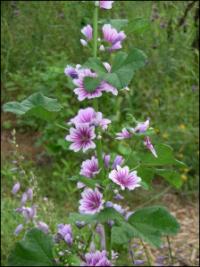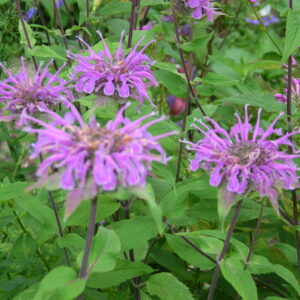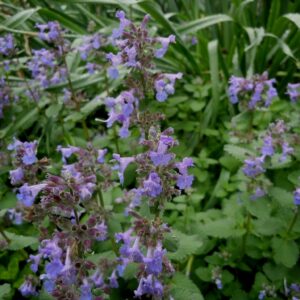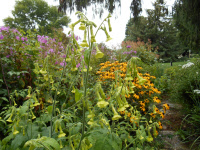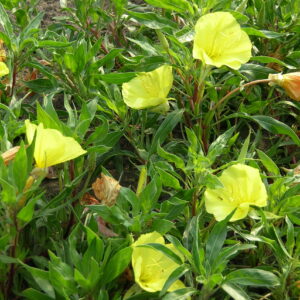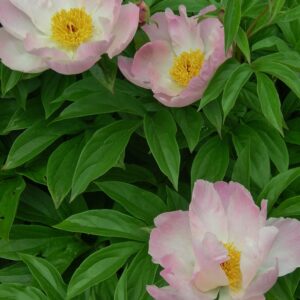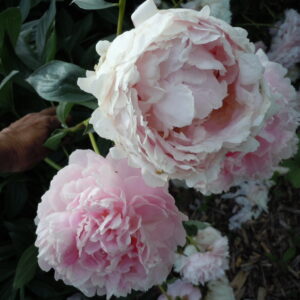Drought, Xeric & Dry Soil Plants
Showing 73–80 of 126 results
-
Malva sylvestris ‘Zebrina’ Striped mallow – According to the books a perennial, but here it acts like an annual that reseeds – just watch for the seedlings in early summer. Z 5-8
June to October pink with purple striped mallow flowers
June to October pink with purple striped mallow flowers
Size: 36-48" x 24"
Care: Sun, moist well-drained soil. Moderately fertile.Malvas have been cultivated for food or flower since 6000 B.C. This was identified by Dioscorides in De Materica Medica for medicinal use around 70 A.D. Flowers and young leaves are edible – add petals to salads. The Malva sylvestris ‘Zebrina’ was listed as cultivated in the empire pursuant to Charlemagne’s Capitulare de Villis c. 800 A.D. The French word “mauve” comes from the color for this flower. Pressed specimen in Emily Dickinson’s herbarium.
-
Monarda fistulosa Wild bergamont Z 3-9
Whorls of hooded lavender tubes in July - August
Whorls of hooded lavender tubes in July – August
Size: 3-4' x 2' spreading
Care: Sun to part shade any soil.
Native: central U.S., Wisconsin native
Wildlife Value: Checkered white, Tiger swallowtail, Giant swallowtail and Melissa blue butterflies relish Wild bergamot’s nectar. Supports over 70 bee species including Rusty patched Bumble Bee.Used medicinally by many Native tribes- Blackfoot, Cherokee, Chippewa, Choctaw, Crow, Dakota and Flathead. Cherokee: to cure colic, flatulence, nosebleed, measles, flu, hysteria and to induce restful sleep Blackfoot called it “Single-young-Man.” Teton Dakotas boiled the leaves and flowers for medicine to cure abdominal pain. Ho-Chunk boiled the leaves to make a medicine for pimples. Choctaws cured chest pain in children. The Flathead cured colds and sore teeth with Wild Bergamot. HoChunk inhaled fumes in a sweat bath to cure colds. Oneidas made a tea. For the Sioux it was nourishment and a panacea: tea, stomachache, fever, indigestion, sore throats, fainting, whooping cough, wounds, sore eyes, ulcers, and snakebites. First documented by French explorers before 1635. Plant exported to Europe by Tradescant the Younger in 1637. Grown by Washington at Mount Vernon. Today it is a flavor in Earl Grey tea.
-
Nepeta racemosa syn. N. mussinii Catmint Z 4-8
Lavender blue from May through September, cut back for rebloom
Lavender blue from May through September, cut back for rebloom
Size: 18" x 18"
Care: Full sun in well-drained soil
Native: Caucasus
Wildlife Value: attracts butterflies and bees
Awards: Royal Horticultural Society Award of Merit.Nepetas may have been named after Nepete, an old Etrusrian city. Mussinii named for the plant’s discoverer, Russian Count Apollos Apollosovitch Mussin-Pushkin. In gardens before 1810 and a favorite Victorian bedding plant by the late 1800’s. Catmints contain various amounts of an essential oil (nepetalactone) both a cat stimulant and a mosquito repellant.
-
Nicotiana langsdorffii Langsdorff’s tobacco Z 10-11, grow as annual in colder areas
Pendulous Granny Smith apple colored, tube-shaped flowers in summer through fall.
Pendulous Granny Smith apple colored, tube-shaped flowers, in summer through fall.
Size: 2-3’ x 6”
Care: full sun to part shade in well-drained soil
Native: Chile and Brazil
Wildlife Value: attract hummingbirds
Awards: England’s Royal Horticultural Society Award of Merit.Nicotiana langsdorfii introduced in 1819. The genus name nicotiana named after John Nicot who introduced smoking tobacco to Europe. Langsdorfii named to honor Russian naturalist Georg Heinrich von Langsdorff, Baron de Langsdorff ( 1774 -1852), Russian consul general in Brazil and leader of Langsdorff Expedition of Brazil, 1826-1829.
-
Oenothera macrocarpa syn. O. missouriensis Ozark sundrops Z 3-7
Big, lemon-yellow blossoms much of the summer, then turn into curious-looking, big oval seed pods
Big, lemon-yellow blossoms much of the summer, then turn into curious-looking, big oval seed pods
Size: 9-12" x 12"
Care: sun in well-drained soil
Native: Missouri & Nebraska
Awards: Royal Horticultural Society Award of Merit.Oenothera is Greek meaning wine tasting referring to the ancient use of Sundrop roots. This discovered in 1810 by Thomas Nuttall when he traveled along the Missouri River “on the elevated summits of the …hills in the vicinity of the lead-mines of the river Meremeck, 30 miles from St. Louis, Louisiana.” (then in the Louisiana Territory). Nuttall described it as a “splendid and singular species.”
-
Paeonia ‘Seashell’ Sea Shell peony Z 3-8
Blousy, single, ballerina pink petals 6” across, surround golden centers in mid-season, sweetly fragrant.
Blousy, single, ballerina pink petals 6″ across, surround golden centers in mid-season, sweetly fragrant.
Size: 36"x 36"
Care: sun to part sun in moist well-drained soil. Plant “eyes” no deeper than 2” below soil. If planted too low, it will not flower.
Wildlife Value: Deer resistant.
Awards: American Peony Society Gold Medal in 1990.Paeonia is derived from the Greek mythical figure Paeon, who Pluto turned into a flower. Theophrastus described the peony around 300 B.C. Dioscorides, 1st century A.D., claimed the root eased the pain of childbirth. During the Middle Ages peonies used in Europe to remedy the falling sickness, cleaning women after child birth, nightmares, and melancholy. The “surest way” to effect a cure was to hang fresh root around the neck. Otherwise an infusion should be taken before and after a full moon. ‘Seashell’ introduced by H.F. Sass in 1937.
-
Paeonia ‘Butterbowl’ Peony Z 2-8
Pale pink single petals surround blousy yellow central petals, hence ‘Butterbowl.’
Pale pink single petals surround blousy yellow central petals, hence ‘Butterbowl.’ Fragrant too. Blooms midseason.
Size: 36” x 24-30”
Care: sun to part sun in fertile, moist well-drained soil. Plant “eyes” no deeper than 2” below soil. If planted too low, it will not flower.Paeonia is derived from the Greek mythical figure Paeon, physician to Pluto who cured Pluto after his defeat by Hercules. In thanks Pluto turned Paeon into a flower. Peonies have been in gardens since Greek and Roman times. ‘Butterbowl’ bred and introduced by Rosenfield, 1955.
-
Paeonia ‘Sarah Bernhardt’ Peony Z 3-8
Huge, frilly pastel pink blossoms late in the season, fragrant
Huge, frilly pastel pink blossoms late in the season, fragrant
Size: 36” x 36”
Care: sun to part shade in moist well-drained soil. Plant "eyes no deeper than 1-2" below soil level
Awards: Royal Horticultural Society Award of Merit.Paeonia is from Greek mythical figure Paeon, physician to Pluto who cured Pluto after his defeat by Hercules. In thanks Pluto turned Paeon into a flower. Peonies in gardens since ancient Greece. P. ‘Sarah Bernhardt’ introduced by French nursery Lemoine in 1906.

